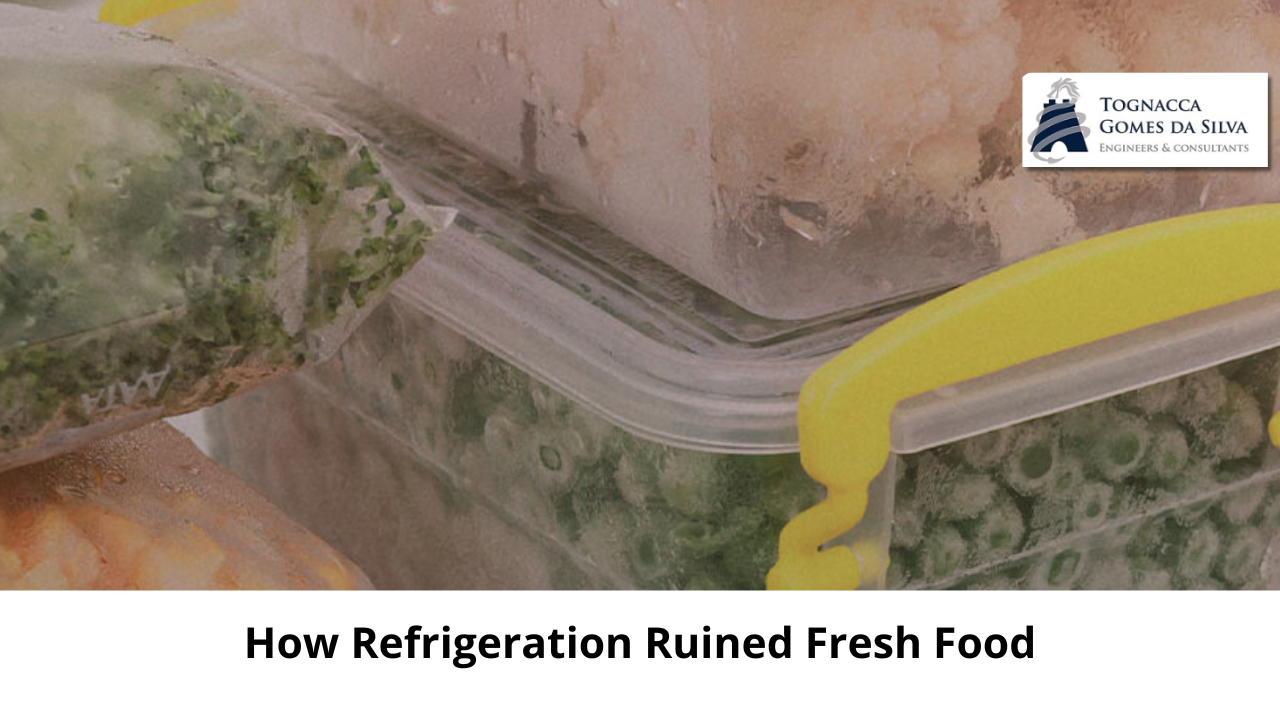Before you buy orange juice, it’s probably been stored for up to two years in a two-story stainless steel tank containing 265,000 gallons of a viscous brown paste. It’s still orange juice, but with the water and volatile flavor molecules removed. The result is a simple syrup that’s six times sweeter than the original juice and has none of the orange’s fruity, floral freshness.
Bananas? They may not be refrigerated in the supermarket, but they’re the quintessential refrigerated fruit. Only thanks to what Nicola Twilley calls “a continuous network of thermal control” have they managed to become a global commodity rather than a luxury. And that bag of salad you picked up for dinner? It’s not just a plastic bag, but, as Twilley explains in his new book Frostbite: How Refrigeration Changed Our Food, Our Planet, and Ourselves , “a technologically engineered respiratory apparatus designed with layers of semipermeable films to slow the metabolism of spinach, arugula, and endive and extend their shelf life.”
Three-quarters of everything in the average American diet, she explains, passes through the cold chain—a network of warehouses, shipping containers, trucks, refrigerated display cases, and home refrigerators that keep meat, milk, and other products chilled during their journey from farm to plate. As consumers, we place great trust in terms like “fresh” and “natural,” but artificial refrigeration has created a blind spot, Twilley says. We’ve become so efficient at preserving (and storing) food that, as she writes, “we know more about how to extend the shelf life of an apple than we do about a human being,” and most of us never think about this extraordinary process.
But it’s not all good: Refrigeration is a major contributor to global warming and ozone depletion, so much so that Project Drawdown, a climate solutions nonprofit, points to refrigerant management as the single most important action we can take to mitigate climate change.
“What we eat, how our food tastes, where it is grown, and how it affects both our health and the planet: these issues shape our daily lives and our survival as a species,” Twilley writes, “and all of them have been completely transformed by artificially produced cold.”
Twilley—a frequent New Yorker contributor and co-host of the Gastropod podcast, which explores food through the lens of science and history—offers a behind-the-scenes look at the cold chain in her book, concluding that “our food system is frozen: it has been crippled by exposure to cold.” We have gained convenience, but at the expense, she writes, of “diversity and flavor.”
Twilley believes that refrigeration is a technology that is enabling many of the problems of our current food system, from the push for scale and monoculture to the measurable reduction in the nutritional value of fruits and vegetables—not to mention the damaging impacts on the environment. Its impact on global warming and ozone depletion is so significant that, she says, Project Drawdown singles out refrigerant management as the single biggest action we can take to combat climate change.
“Our food system is frozen: it has been damaged by exposure to cold.”
We use refrigeration to solve problems, but we’ve never really taken stock of the environmental, nutritional and even sociocultural costs, argues Twilley. “The point of my book was to ask, ‘Could we do things better?’” Check out the conversation with the author:
You spent years researching enclosed spaces for your previous book, Until Proven Safe: The History and Future of Quarantine, which you co-wrote with your frequent collaborator and husband, Geoff Manaugh. In some ways, it feels like refrigerated food is in quarantine.
Yes! Quarantine and refrigeration are both peculiar ways of manipulating space and time. With refrigeration, you build specific spaces to store food, which act as a sort of time machine, allowing you to extend its shelf life and transport it around the world. You are manipulating geography. With quarantine, you are using space and time to ensure that you do not contract a disease. Ultimately, both are about controlling nature.
I would never have thought of refrigeration as a spatial issue, but it makes sense.
What interested me was the idea that we’ve created a huge artificial winter for our food to live in—an artificial cryosphere that’s mostly invisible.
You have to go back to when I first started getting interested in this, about 15 years ago. Back then, everyone was talking about the farm-to-table movement—Michael Pollan, Eric Schlosser, Alice Waters. Every trendy restaurant was farm-to-table. But the focus was always on the farm, and that got me curious about the “to” part—how food gets from the farm to the table.
Pollan showed us how a cattle feedlot works, so I thought, maybe I can show people the spaces we’ve created to store food after it’s harvested.
We’ve created this incredibly sophisticated architecture for food to live between the farm and the table. Foodies tend to visit farms, but they don’t visit this in-between space. So, yeah, it started as a spatial issue.
All of the mechanical, chemical, and manipulative processes involved in refrigeration seem to completely contradict everything the farm-to-table movement advocated at the time.
Absolutely. I think that’s a big blind spot for most people, and as a journalist and writer, blind spots are always interesting. They’re where the good stories are. I don’t think you can understand our modern food system without understanding refrigeration — and until now, no one has really explored that topic.
You write that “freshness is a belief system.” Can you explain more about that?
Our notion of freshness has changed dramatically. People don’t know how long ago their food was harvested—and that’s a deliberate strategy by the industry. Companies don’t tell you how long ago milk was bottled—only when you should throw it out. Dates like “best before” and “sell by,” which became popular in the 1970s, are frameworks that provide a sense of security but have no real scientific basis.
I’ve told people, “Hey, if you’re buying an American apple in July, that apple is about to turn a year old.” That makes them uncomfortable. They simply have no idea how old their food really is.
In the 1880s, when people first came into contact with refrigerated food, many people saw it as immoral and dangerous. It was like zombie food. Imagine that up until that point, you knew what fresh food was, and then suddenly you come across something that completely defied that notion. People felt like they were being tricked, tricked, cheated, poisoned. Of course, in many cases they were being poisoned, because the early operators of refrigerated warehouses didn’t know exactly how to store food safely. The extraordinary thing is that from the perspective of the 20th and 21st centuries, we think that if something isn’t refrigerated, then it can’t be fresh, right? In the book, I quote historian William Cronon [author of Nature’s Metropolis: Chicago and the Great West, published in 1991] — and here I’m paraphrasing — who says that the greatest impact of refrigeration has been forgetfulness.
It has disconnected us from the origins of our food and turned our understanding of freshness into a belief system, removing any certainty or proximity to the provenance of the food we consume.
I was also struck by a line in your book: “Cold is the absence of heat.” You write that “there is no such thing as cold, in the sense of being a thing, a force, or a property that exists and is measurable in its own right.” For people like me, who have always thought of cold as the opposite of heat, what does that really mean?
I didn’t start thinking about what cold actually is, as opposed to its effects, until the very end of writing the book. That’s when I thought, Wait, I should learn how to make cold. And then I realized that you don’t actually make cold. Cooling is nothing more than the perception of heat loss as it’s transferred somewhere else. It’s almost poetic. Cold is absence.
As part of my research, I built a refrigerator to understand how it works. It’s an incredibly ingenious piece of thermodynamics. You can see why it took humans so long to figure out how to make it. People have always known that cold has a preservative power, but we hadn’t figured out a way to control it for most of history. Galileo, Francis Bacon, Leonardo da Vinci, Robert Boyle—they all tried to understand cold. What the hell is it? Where does it come from?
The first person to produce cold on demand was Scottish physician William Cullen in the late 18th century, and he didn’t really know what to do with it—it was almost like a party trick. You’d think the first human to make fire would immediately realize he’d discovered something transformative. But the first human to make ice artificially didn’t have the same reaction. That still amazes me.
I look at those old pictures of giant blocks of ice and the idea that someone thought transporting them was a good plan seems absurd to me.
When you read about Frederic Tudor’s attempts in 1806 to ship ice around and get rich off it, everyone thought he was crazy. The list of reasons why this was a terrible idea goes on and on: ice is heavy, slippery, cold, and when it’s available for shipping, guess what? It melts. By all accounts, it was a ridiculous project, and people told him so at the time. But without Tudor, I don’t think people would have really realized that large-scale cold isn’t just something useful for, say, ice cream or cold drinks in the summer. It completely redefined the way we transport food around the world.
Are we basically making the world less habitable as we improve refrigeration?
Much of history has been a battle between us and decay. A refrigerator doesn’t stop decay; it only slows it down. The feeling that we’ve won this battle leads to massive food waste. People treat their refrigerators like safes—they put something in there and believe it’s safe. Before home refrigerators, no one hoarded perishable food in the same way. Now that we can, we waste much more food at the consumer level. We’ve been fooled by the endless abundance of supermarkets.
Fridges have gotten bigger, and many families now have more than one. People drive to the supermarket, filling their refrigerators and freezers to the point where they can’t even find the food in them anymore. This behavior even changes the layout of cities: houses get bigger, roads get wider, stores need bigger parking lots. Everything is interconnected in ways that have really negative environmental impacts.
But food preservation doesn’t have to rely solely on refrigeration. For me, the most exciting part is that by understanding how the cold chain works, we can redesign it. We can create a food system that produces tastier, healthier, and more environmentally friendly food. There are alternative methods of preservation. One example is Apeel coating, which — like refrigeration — works by slowing the rate at which food respires. It does this by adjusting the atmosphere, rather than controlling temperature. Using this nanoscale coating on fruits and vegetables, it’s possible to achieve the same shelf life as you would get in a refrigerator.
Refrigeration has only been the answer for 100 years, but it doesn’t have to be our only solution for the future.
( fonte: MIT Technology Review)



